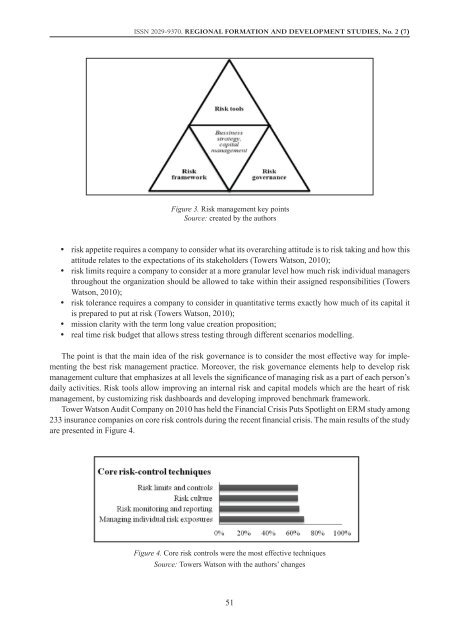regional formation and development studies - KlaipÄdos universitetas
regional formation and development studies - KlaipÄdos universitetas
regional formation and development studies - KlaipÄdos universitetas
You also want an ePaper? Increase the reach of your titles
YUMPU automatically turns print PDFs into web optimized ePapers that Google loves.
ISSN 2029-9370. Regional Formation <strong>and</strong> Development Studies, No. 2 (7)<br />
Figure 3. Risk management key points<br />
Source: created by the authors<br />
• y risk appetite requires a company to consider what its overarching attitude is to risk taking <strong>and</strong> how this<br />
attitude relates to the expectations of its stakeholders (Towers Watson, 2010);<br />
• y risk limits require a company to consider at a more granular level how much risk individual managers<br />
throughout the organization should be allowed to take within their assigned responsibilities (Towers<br />
Watson, 2010);<br />
• y risk tolerance requires a company to consider in quantitative terms exactly how much of its capital it<br />
is prepared to put at risk (Towers Watson, 2010);<br />
• y mission clarity with the term long value creation proposition;<br />
• y real time risk budget that allows stress testing through different scenarios modelling.<br />
The point is that the main idea of the risk governance is to consider the most effective way for implementing<br />
the best risk management practice. Moreover, the risk governance elements help to develop risk<br />
management culture that emphasizes at all levels the significance of managing risk as a part of each person’s<br />
daily activities. Risk tools allow improving an internal risk <strong>and</strong> capital models which are the heart of risk<br />
management, by customizing risk dashboards <strong>and</strong> developing improved benchmark framework.<br />
Tower Watson Audit Company on 2010 has held the Financial Crisis Puts Spotlight on ERM study among<br />
233 insurance companies on core risk controls during the recent financial crisis. The main results of the study<br />
are presented in Figure 4.<br />
Figure 4. Core risk controls were the most effective techniques<br />
Source: Towers Watson with the authors’ changes<br />
51

















